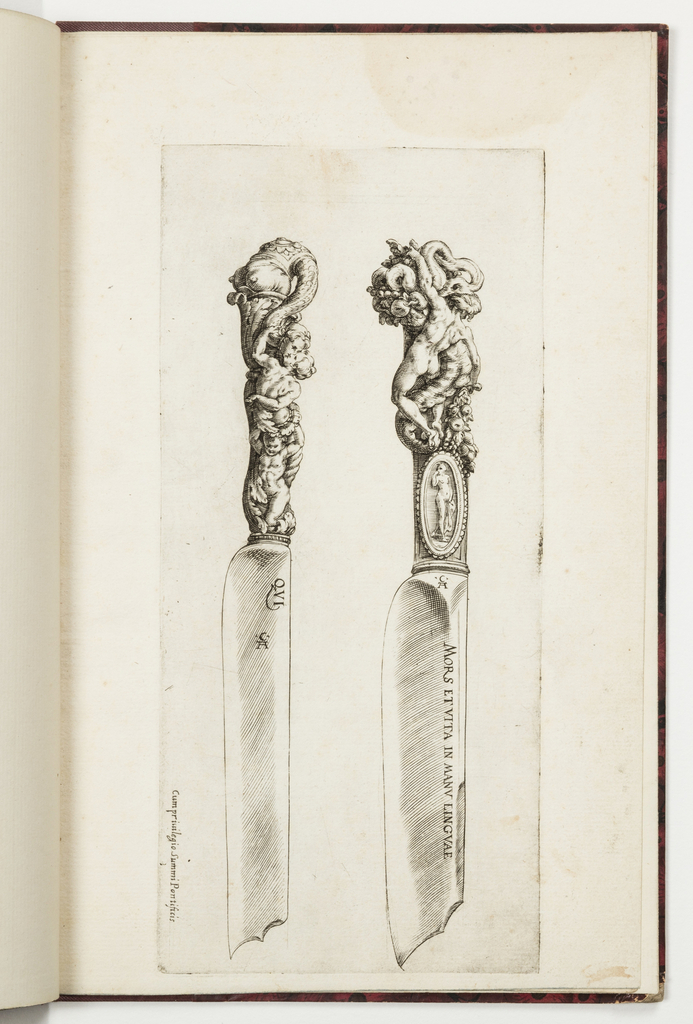There is one other image of this object. This image is in the public domain (free of copyright restrictions), and as such we offer a high-resolution image of it. See our image rights statement.
Object Timeline
|
1920 |
|
|
2006 |
|
|
2016 |
|
|
2025 |
|
Print, Design for Two Knife Handles
This is a Print. It was designed by Francesco Salviati and print maker: Aegidius Sadeler and published by Cherubino Alberti. It is dated 1583 and we acquired it in 1920. Its medium is engraving on off-white laid paper. It is a part of the Drawings, Prints, and Graphic Design department.
“Death and life are in the power of the tongue,” warns a proverbial inscription on a knife blade imagined by Francesco Salviati. Knife handles further illustrate the tongue’s pleasures and perils, and these sensuous yet violent scenes seem to caution diners about to indulge. On one handle, a figure risks a snakebite to reach into a cornucopia of fruit. On the other, a woman holds her severed head in a serpentine arm as it kisses a recumbent lover.
This decapitated torso, with its protuberant bust and scaly skin, could make even sworn carnivores queasy, but it suits a tool for slicing and chopping. Executed in precious metal, bone, or coral, these knives could have been used at a courtly banquet. But in the sixteenth century, as today, decadent dining could quickly turn gluttonous. Even kings were known to eat with their hands.[1] In his cutlery, Salviati subversively weds the savage and carnal, tempting and testing our appetites.
Salviati was trained from an early age in goldsmithing, and though he made his reputation as a painter, Giorgio Vasari writes that he maintained a lifelong ambition to sculpt, and cast small, “extremely witty and graceful” figures in bronze.[2] In works like his 1550 deposition fresco for the Markgrafen Chapel in Rome’s Santa Maria dell’ Anima, or the below drawing of three nudes, his contorting figures seem to break through the flat picture plane, thrusting into a third dimension.
It’s fitting, then, that Salviati’s designs for cutlery take full advantage of every angle. Accentuating the S-curves of these earlier works, he twines torsos and tails around the axis of each handle, guiding the eye across its surface. As diners turned the knives over in their hands, more of the lascivious scene would reveal itself.
This object and many more grotesques are included in the exhibition Fragile Beasts, which is on view at Cooper Hewitt through January 16, 2016.
Virginia McBride is a Curatorial Assistant in Cooper Hewitt’s Department of Drawings, Prints & Graphic Design.
[1] Sarah D. Coffin and Darra Goldstein, Feeding Desire: Design and the Tools of the Table, 1500–2005 (New York: Cooper Hewitt, Smithsonian Design Museum and Assouline Publishing, 2006), 38m 266.
[2] Vasari, Le Vite…, ed. 1996-87, vol. 5, quoted in “Francesco Salviati” in Linda Wolk Simon and Carmen C. Bambach, An Italian Journey: Drawings from the Tobey Collection, Corregio to Tiepolo (New York: Metropolitan Museum of Art and Yale University Press, 2010), 63.
This object was
donated by
Advisory Council.
It is credited Purchased for the Museum by the Advisory Council.
- Chrysanthemum Pattern Butter Knives Knives
- silver.
- Gift of Anonymous Donor.
- 1957-61-49-a,b
- Print, Two Knives
- engraving on off-white laid paper.
- Gift of William H. Schab.
- 1944-84-1
- Carving Knife with Antler Handle and Boar's Head Terminal Knife
- steel, antler, silver.
- Bequest of Julian Clarence Levi.
- 1972-5-3-b
Our curators have highlighted 10 objects that are related to this one. Here are three of them, selected at random:
- Folding Traveling Knife with Ivory Handle Knife
- ivory, steel, gold plated, brass.
- The Robert L. Metzenberg Collection, gift of Eleanor L. Metzenberg.
- 1985-103-178
- Print, Design for Two Knife Handles
- engraving on off-white laid paper.
- Purchased for the Museum by the Advisory Council.
- 1921-6-350-2
- Print, Designs for Two Knife Handles
- engraving on paper.
- Museum purchase from General Acquisitions Endowment and through gift of Mrs.....
- 1995-47-1
Its dimensions are
Platemark: 25.4 x 11.7 cm (10 x 4 5/8 in.)
It is inscribed
Printed upper right, on knife, in plate: CA / MORS ET VITA IN MANU LINGUAE; Printed lower right, on knife, in plate: QVI / CA; Printed lower right, on plate: cum privilegio summi Pontificus
Cite this object as
Print, Design for Two Knife Handles; Designed by Francesco Salviati (Italian, 1510 – 1563); Print Maker: Aegidius Sadeler (1570 – 1629); Published by Cherubino Alberti (Italian, 1553–1615); Italy; engraving on off-white laid paper; Platemark: 25.4 x 11.7 cm (10 x 4 5/8 in.); Purchased for the Museum by the Advisory Council; 1921-6-350-1
This object was previously on display as a part of the exhibitions Fragile Beasts and Feeding Desire: Design and the Tools of the Table, 1500-2005.






